In this part of the Star. The Golden Ratio I will touch upon such “pseudoscientific” research area as ley lines. Why is it pseudoscientific? Because, according to official science, pyramids, for instance, are mere sepulchres constructed within several decades by slaves who were carrying those large-tonnage blocks like “Barge Haulers on the Volga”, and nothing more. They don’t admit any special pattern in location of the sepulchres. I remember when our teacher was telling us about the pyramids at history classes, surely expounding the official version, he smiled, apparently not believing in what he himself was telling. Almost a quarter of a century has passed since then, while things haven't got forward an inch as they say. The so-called official science keeps turning a blind eye to facts regarding the pyramids and other cult buildings.
However, when we close our eyes we “see” the darkness, though it doesn’t mean there is no world around us. Therefore, such science is not interesting for me, and I’d rather call it pseudoscience: they bury their heads in the sand like ostriches and expound their entombed scientific theories from there, while poor school teachers have to communicate such absurd ideas to their students, and the latter have to listen to that, though it’s better for a student to spend that time on writing a little love letter to a classmate he adores.
I shall start with an extract from Sensei-IV book regarding places of power, since ley lines are associated with such places, and it is considered that such places (though not all of them) are situated on ley lines.
“Nevertheless, there are still some ‘holy places’ which are marked by the presence of power,” Victor uttered. “That is, a human as if gets an additional spiritual power there.”
“Surely, there are such places,” Sensei confirmed. “But let’s distinguish things. There are places of power where power is really present, and there are the so-called ‘holy places’ associated with some events or activities of figures of one or another religion. The difference between these notions is big. And places of power hardly always coincide with the ‘holy places’. Moreover, unfortunately, ministers of religion often speculate on ‘holy places’. Man is imposed a thought (and he agrees with it mostly due to his own laziness) that instead of working on himself it’s easier to go on a travel and visit a ‘holy place’, then all his sins will be forgiven, and he can easily ‘continue to sin’. In reality, however, no matter how many ‘holy places’ man visits, nothing will change in him without a serious inner self-improvement work.
As for places of power, they have always existed, exist now and will further exist. Sometimes they coincide with ‘holy places’. Such places were marked long before Christianity emerged and were worshipped in other religions and beliefs. Often, when one religion was being replaced with another, buildings of the former leading religions were destroyed and new ones were erected for worshipping of other gods. You don’t need to look for examples far away. Just take our history: when Christianity was introduced in Kievan Rus, heathen temples were destroyed, and churches were constructed in their place.”
***
“So, in those times Christian saints took over the function of ‘pagan’ gods. Christian churches were built on the places of former heathen temples, especially those which were popular among people. Holidays were renamed, but Slavic traditions were mainly preserved. For example, the Christian holiday of Easter was merged with the holiday of the Sun and Perun. In some remote areas of Russia the Holy Week is still called the ‘thundering week’.
Because of its popularity among people, the Russian Maslenitsa (“the pancake week”, a purely Slavic holiday) was also included into the holiday calendar as the Shrovetide week before the Lent.”
Ley lines, also the world lines (French lignes du monde), are a concept that is still considered pseudoscientific and identifies the lines on which numerous places representing a geographical or historical interest are located, such as ancient monuments, megaliths, mounds, holy sites, natural ridges, mountain tops, water fords, and other noticeable reference points. Ley lines make up geometric shapes of various scales which altogether form a unified network of, supposedly, force lines of the global energy field.
The existence of ley lines in England as well as their name was suggested in 1921 by the English amateur archaeologist Alfred Watkins who expounded his theory in the book The Old Straight Track (1925) considered to be the first book on ley lines. Later on Watkins suggested a theory that these lines had been created to facilitate travelling by land and navigation in the late Stone Age and existed for millennia.
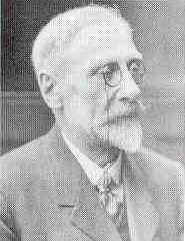
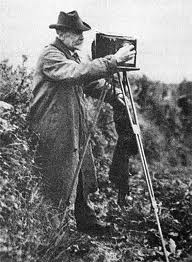
On 30 June 1921, Watkins visited Blackwardine village in Herefordshire and discovered to his delight that several hills with ancient ruins could be joined by a straight line. His imagination let him see a system of straight lines connecting all marked features of the neighbourhood.
Several years later Watkins wrote the following words that most probably reflect his impressions of that summer day:
“Imagine a fairy chain stretched from mountain peak to mountain peak, as far as the eye could reach, and paid out until it touched the “high places” of the earth at a number of ridges, banks, and knowls. Then visualize a mound, circular earthwork, or clump of trees, planted on these high points, and in low points in the valley other mounds ringed round with water to be seen from a distance. Then great standing stones brought to mark the way at intervals, and on a bank leading up to a mountain ridge or down to a ford the track cut deep so as to form a guiding notch on the skyline as you come up.”
“A visit to Blackwardine led me to note on the map a straight line starting from Croft Ambury, lying on parts of Croft Lane past the Broad, over hill points, through Blackwardine, over Risbury Camp, and through the high ground at Stretton Grandison… I followed up the clue of sighting from hill top,... found it yielding astounding results in all districts, the straight lines to my amazement passing over and over again through the same class of objects.”
Watkins was not the first one to assume that ancient monuments had been erected to designate remarkable positions of the Sun and the Moon, and that a number of structures were located along a single line. In the early 20th century Sir Norman Lockyer examined orientation of ancient structures in different parts of the world. In his book Stonehenge and Other British Stone Monuments Astronomically Considered (1909 revised edition) he indicated the alignment of Stonehenge, Old Sarum, Salisbury Cathedral, and Clearbury Ring. He also ascertained that the CrowleyCastle forms an equilateral triangle with Stonehenge and the hill fort of Old Sarum. The distance between these sites is about 9.6 kilometres (6 miles).
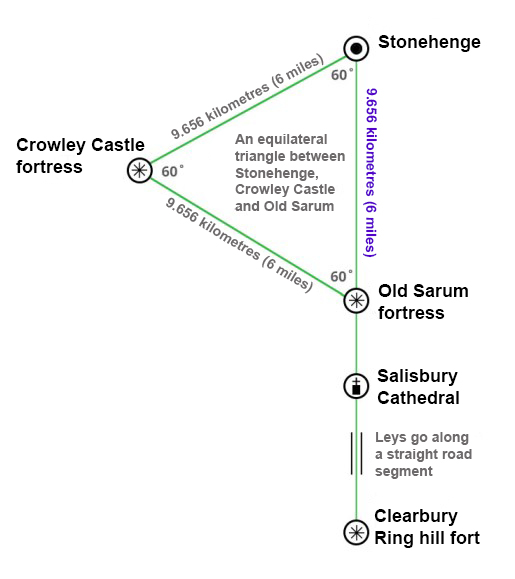
William Henry Black was a historian, employee at the National Archives in London and member of the British Archaeological Society. He also noticed the mysterious lines and as long ago as in 1870 made a statement about them at one of the Archaeological Society meetings. Addressing those who were present, Black declared:
Monumental structures well-known to all of us serve as if for marking huge geometric lines — the lines passing throughout Western Europe, the BritishIslands, Ireland, Hebrides, Shetland and Orkney Islands up to the polar circle… Such lines also exist in China and all countries of the East, and everywhere they follow the same scheme.
In order to verify his theory, Watkins did the following: he took a map of one of Southern England districts, calculated 51 churches and started searching for lines on the map. He discovered 38 lines connecting 3 churches, 8 lines connecting 4 churches, and only one line that connected 5 churches. Then he randomly drew 51 points on a sheet of paper. There were 34 coincidences for three points, just one coincidence for 4 points, and no coincidences for 5. Thus he concluded an accidental coincidence was possible for 3 points. But if there are more points, this should be a certain plan.
It is known that some Christian churches were constructed right in the place of megalithic monuments. A vivid example may be observed in Arrechinaga, Spain, where a huge megalith is located inside the Church of St. Michael built in the place of his supposed hermitage. In Northern England, in the yard of a church in Radstone (Yorkshire), there is the largest stand-up stone in the BritishIslands, 25 feet tall. There are numerous well-known examples indicating that local inhabitants remembered such sacred sites, despite the change of religion. Late Glyn Daniel, Professor of Archaeology at the University of Cambridge, once wrote:
Perhaps, this sounds too straightforward, but I can hardly imagine why Christians constructed their churches in the place of certain megalithic structures unless there was a true tradition emphasizing the particular importance of such places as of special and sacred sites, a tradition that was transferred from the Bronze Age and the early Iron Age of barbarian Europe to the historic times.
There are many advocates as well as opponents of the ley line theory, and both parties suggest interesting arguments, including those based on math calculations. Herein I won’t refer to their conclusions which are freely available on the web. I would only like to give a brief historical note.
Since we’ve mentioned Stonehenge, I’d like to note an interesting point. The distance between Stonehenge and the Great Pyramid is 3,600 km. The distance from Stonehenge to Baalbek is 3,600 km. The distance from the Great Pyramid to Mohenjo Daro is about 3,612 km, i.e. the same 3,600 km. A coincidence?... I doubt.

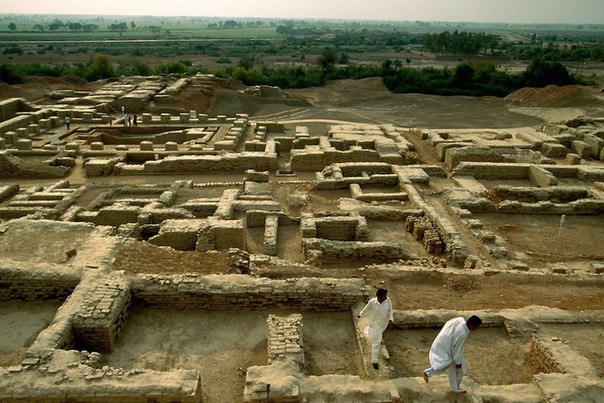
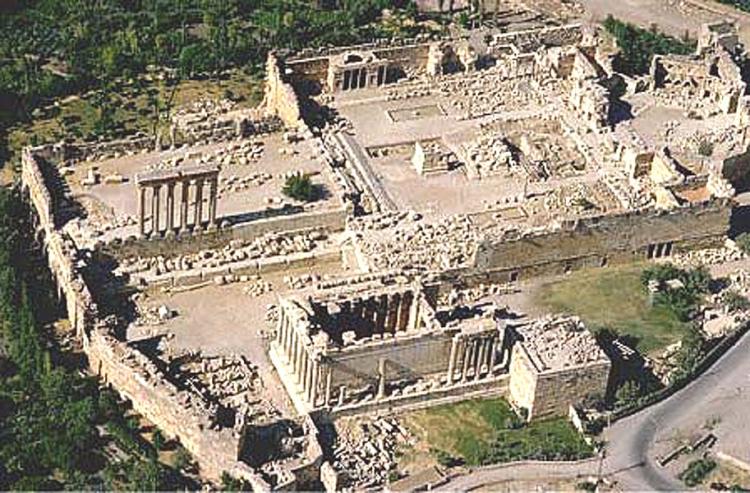
Here I guess it would be appropriate to cite a couple more extracts from Sensei-IV book:
“It’s natural that people associate Bodhisattvas with gods,” Sensei said when silence ensued. “For their knowledge and ability to control the matter (including control of nature without any ’technical means’ and possession of other supernatural abilities) would shock even contemporary people with all their piles of information about ‘advanced’ technologies, not to mention those who lived at the time of this human civilization birth. The contacts were indeed very frequent, since Bodhisattvas of Shambala not only protected people, but also gave them knowledge, starting from elementary knowledge (how to plant seeds, build houses, etc.) and up to spiritual practices. That is why people started to believe that gods needed to assume a human appearance in order to contact people. For example, such gods as Ptah and Osiris were not a mere mythical figment, but real personalities of Bodhisattvas who once lived among people. But the story of their life was severely changed into a myth by people and simplified to the level of human comprehension, and moreover was tied to a concrete geographical region. However, as a rule, the activity of Bodhisattvas of such a level in those times covered not just the lands of Ancient Egypt.”
***
“So, Bodhisattvas, when among people, not only took care of people like about babies in a cradle, but it was natural that they communicated with representatives of other civilizations… And there’s nothing extraordinary in this. In principle, mankind has a chance to evolve to such a level within the next hundred years that they will be able to freely visit other worlds. And at those times such communication between Bodhisattvas and representatives of other worlds was normal. And it’s quite natural, because no matter how developed a material civilization is it will still strive for communication with more developed creatures, especially since in those times, as I have already said, Bodhisattvas stayed among people for quite a long time.”
“Was it something like a unique chance for representatives of other worlds to learn more than they knew?” Victor made a conclusion.
“Right you are,” Sensei nodded. “That’s why the presence of a cosmodrome not far from Egypt, in the territory of modern Libya, which is preserved until now, by the way…”
“A cosmodrome?!” we asked almost simultaneously.
“Yes,” Sensei calmly replied to our general surprise, having shrugged his shoulders. “Now scientists call it the Baalbek Veranda’. It’s a huge platform built of gigantic blocks, each weighing 360 tons, with special holes on each side of the platform. Archaeologists still rack their brains over its purpose, though unlike world-views of people from previous epochs they started at least to guess that it looks like a cosmodrome,” Sensei grinned. “Their naivety is striking! They look for traces of soot from spaceship fuel and mean by fuel the one with components known nowadays.” Sensei stated with surprise. “What kind of tanks should one have with such fuel in order to go to, for instance, Sirius and to come back?! They are so ridiculous, they look for traces of fuels and lubricants and don’t even assume there are lotst of other sources of alternative energy which are more economical and environmentally friendly. Well, as they say, everybody relies on information available to him.”
Besides the Baalbek Veranda, there were other cosmodromes which didn’t require such a big takeoff-and-landing site. There was a region at the very base of the Nile ‘flower’ for such spaceships. Naturally, such intensive traffic was noticed by people. That is why quite interesting ancient legends about that time were preserved in the memory of generations.”
In view of the aforesaid, a conclusion may be drawn that the 2 sites where peculiar “cosmodromes” of representatives of other worlds were located, i.e. where they landed for communication with Bodhisattvas, are at one and the same distance from Stonehenge. In such case, the function of Stonehenge itself is quite interesting, and the same distance is far from being accidental I think.
Having touched upon the topic of representatives of other worlds, I will smoothly move to another source of information – a big fan of aliens (I didn’t want to refer to him first, and later on you’ll understand why). However, while surfing for information on the subject addressed herein, I saw his works being cited as the primary source, and his works do contain facts which, in my opinion, deserve attention. This is Erich von Däniken. You might ask why I have such an attitude to him. I’m not particularly familiar with his works, just read some fragments from those plus viewed his numerous interviews. Different people believe in different things: some believe in God, others believe only in multicoloured little sheets of paper and shining pieces of metal throughout their life, while von Däniken believes in aliens and only in them. There is a whole chapter in one of his books, entitled Lies Surrounding the Fatima Event. The author writes about himself: “Just like all countless faithful Catholics, I gained Catholic education, and I don’t want to give up the wonderful views of childhood at all. I remember those tuneful songs about Our Lady. In those times I experienced an inexpressible feeling of unity with other believers in the church, I know Gregorian songs and organ music, I inhaled the smell of incense and admired glimmering candles…”
And here's what von Däniken writes about Kukulkan:
God Kukulkan descended from cosmos, spent some time among people and taught them various sciences and skills. Then he left people, having promised them to return later. The Book of Prophet Jaguar says:
“They descended from the stellar road… They spoke the magical language of stars and heaven. Their signs are our confidence in the fact they have descended from heavens. And if they come again, they will regulate what they once created.”
Regarding the Fatima apparitions of Virgin Mary:
The fact that Our Lady appears to people from time to time, and not just in Fatima, gives believers an opportunity to solve their dilemma whether to restore the order in the world or not. If we adopt version с) the version of mimicry, I see the following: someone out there, beyond our world, is playing with us. That someone knows people, their religions and the fact millions of people strongly believe in Virgin Mary. He assumes the role of Our Lady, takes her name and manifests accordingly. And a complete order is restored in the world again. Ave Maria!
What can be said to this? In his interpretation, Kukulkan is an alien, Virgin Mary is a peculiar manifestation of an extraterrestrial will owing to which aliens endeavour to influence the human civilization development, and his interpretation of the Book of Enoch, if I’m not mistaken, also contains aliens only. Here’s a quote:
Whenever I mention Enoch, while I assume the predictor was taught on an alien spaceship, I hear every time: “Well, OK, he must have had some spacesuit in such case.” Must have? Quite probably, vice versa, for aliens must protect themselves against bacteria, viruses and, possibly, even the human sweat. What can the attentive disciple Enoch say to this?
In the UNITY programme there is a moment when Angel manifestations and manifestations of the Holy Spirit are discussed, and it’s being said that such manifestations are possible in the form of fiery spheres or columns, and that some people take such manifestations for aliens. At that point I immediately recalled von Däniken.
So, dismissing all von Däniken’s alien interpretations (may his fans forgive me), I shall refer only to the facts he stated, which deserve attention, I believe.
A network of straight lines covers a large area in Germany. Here’s an example.
On the northern outskirts of Wiesbaden there is Neroberg, an ancient heathen cult place. A line laid from here to the southeast passes through the centre of Wiesbaden, the old part of Mainz, the cathedrals of Worms and Speyer. A coincidence?
Such cities as Aachen, Frankfurt am Main, Würzburg, Nuremberg and Donaustauf are located along a straight line. In approximately three hundred kilometres the line meets Valhalla, where, according to a legend, there is a burial vault of the Norse god Odin.
A network of invisible lines stretches across Europe. Between latitudes 48° and 49° north, to the south of Strasbourg a line starts which runs from the east to the west via little towns of Sainte-Odile, Valmont, Vaudigny, Domremy, Vaudeville, Joinville, Fontainebleau, Domblen, Luz, La Belle Etoile, Pierrefite, Chartres, La Loupe, and others. The line ends on the OuessantIsland not far from the Atlantic coast of France. This line passes not through centres of the towns, but through remains of megalithic structures discovered near the above-listed inhabited localities.

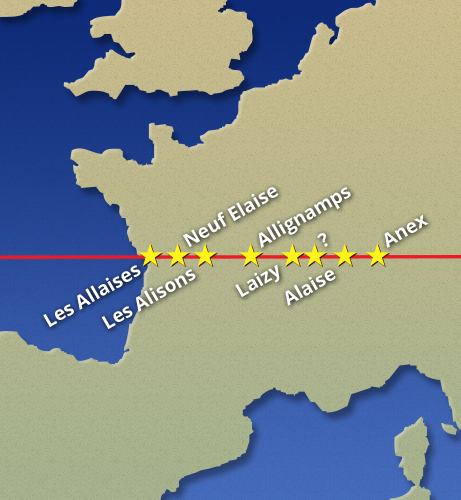
In the northwest of Spain there is a pilgrimage centre of Santiago de Compostela. In 1989, Pope John Paul II called young people to come there for the Fourth World Youth Day. Around three hundred thousand people followed the Pope’s call, and one third of them covered a two-hundred-kilometre route on foot, not even suspecting they were walking along the ancient “heathen line”.
They say Charles the Great himself once went on a pilgrimage to Santiago de Compostela. At that, his route supposedly passed along the “stellar road”.
This is only a legend, and Charles the Great never visited Santiago de Compostela, nonetheless the “stellar road” does exist. Take a map or an atlas and get convinced.
The road starts at 42 degrees 46 minutes north and runs through the Pyrenees from the east to the west. Names of all localities lying on this latitude originate from one and the same word.
The word star sounds stella in Latin, etoile in French, and estrella in Spanish. Now let’s look at the map again. We see such localities as Les Esteilles in Catalonia not far from Luzenac, Estillon to the south of the Pyrenees, Lizarra near Pamplona, Liciella near Bergen in León, and Aster in Galicia. The name of each locality contains a root of the star word. Even in the name of the final point – Santiago de Compostela there is the star word.
The “stellar road” leads from the Mediterranean Sea to the Atlantic via the Pyrenees. The names of all inhabited localities on this route originate from the word star. There is no need to tell that heathen temples existed in every of these places in the Stone Age.”
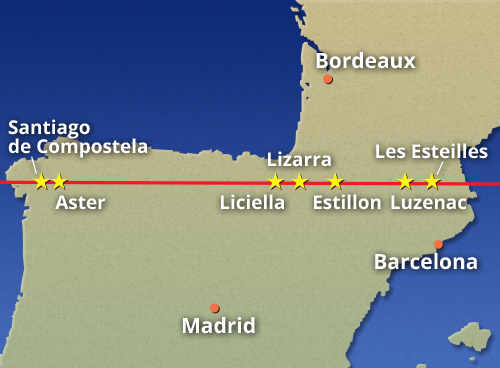
This is a very interesting piece of information regarding the “stellar road”, and here my brain worked in the “stop and look closely” mode, so I shall probably describe the “stellar road” in a separate article which I didn’t plan initially. Let me tell you what kind of baroque I have discovered there.
One of such pentagrams lies over the city of Karlsruhe. It was discovered by Dr. Yene Meller who lives in that locality.
To the north of Karlsruhe, in a town of Eggenstein there is a church erected in the place of a heathen cult site. The line drawn from here via Karlsruhe to the south meets Klosterwald. In prehistoric times, heather rituals were also practiced there. Thereafter the line turns to the northwest and stretches to a church in Bühelberg, then to the east to a church in Klein Steinbach, next to the southwest to St. Wendelin Church in Rastatt-Rheinau, and from there is returns to its starting point – the church in Eggenstein.
The last segment of the line passes through Knielingen which is now absorbed by Karlsruhe. From time immemorial, the coat of arms of Knielingen contained the pentagram, and none of the town elders had an idea how it had emerged there.
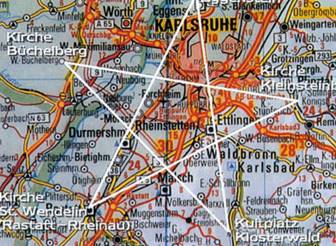
Knielingen is the oldest documentarily evidenced and the second-largest district of Karlsruhe, Germany (with the area of about 2,000 hectares).
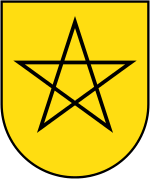
Knielingen coat of arms
Please, note a very interesting disposition of the churches (which were constructed on the sites of former heathen cult places) at the Star vertices. Such disposition cannot be accidental; at least to me it indicates that in ancient times people who lived in these places knew the primordial meaning of the Star sign (in Part 1 of the article series I gave quotes from the AllatRa book regarding this sign). At that, the ancients placed not markets or bazaars at the Star vertices, but rather cult buildings and structures. I totally admit such disposition promoted exactly spiritual unification of people who inhabited this area, and most probably local inhabitants practically used the Star sign as the working sign associated with the forces of Allat.
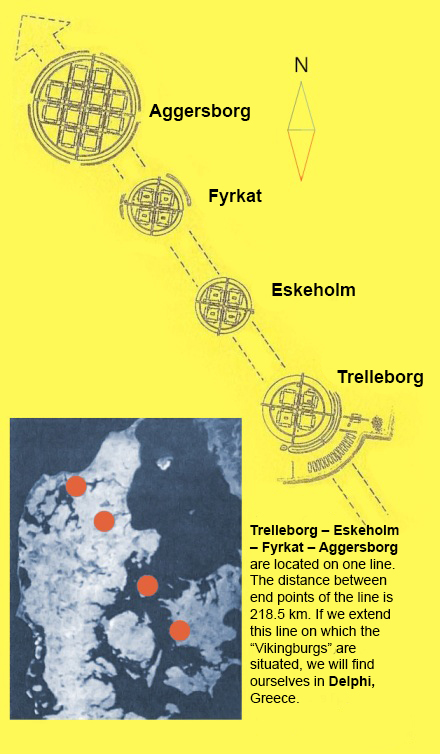
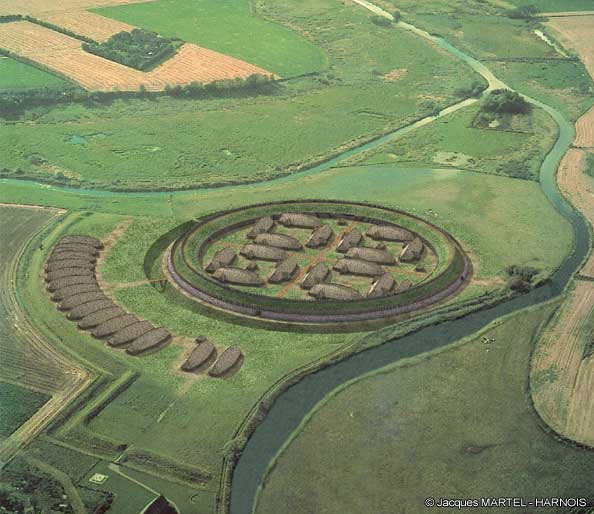
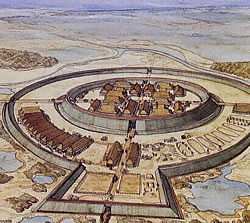
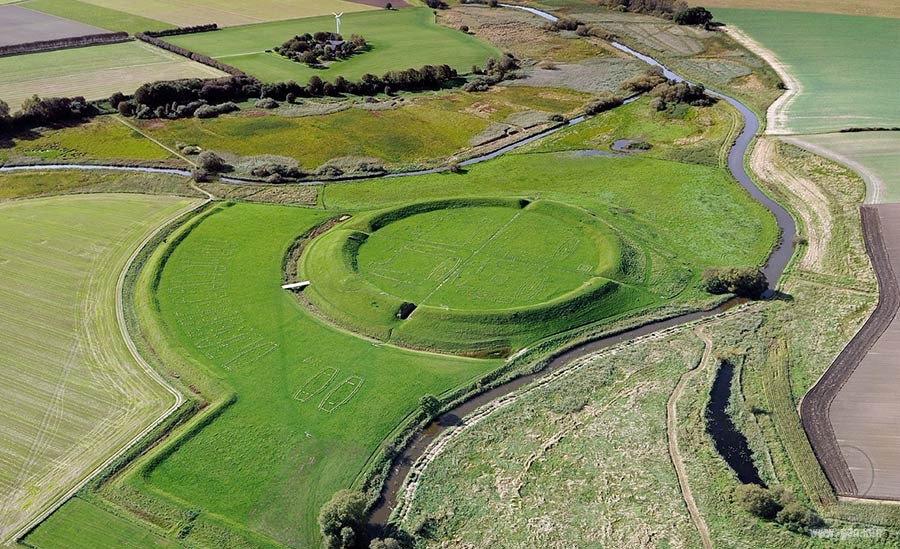
Trelleborg
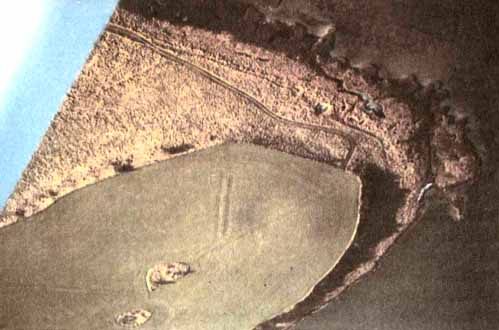
Eskeholm
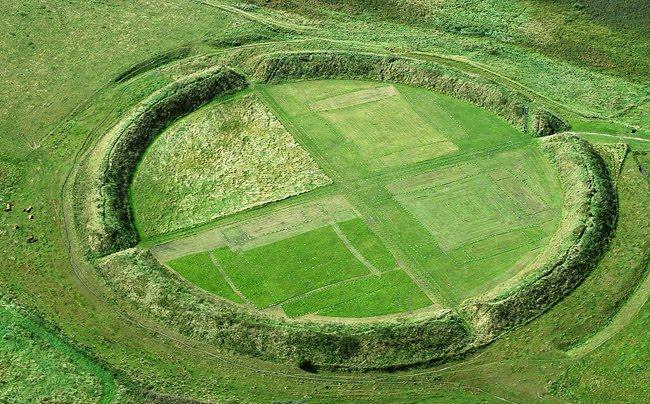
Fyrkat
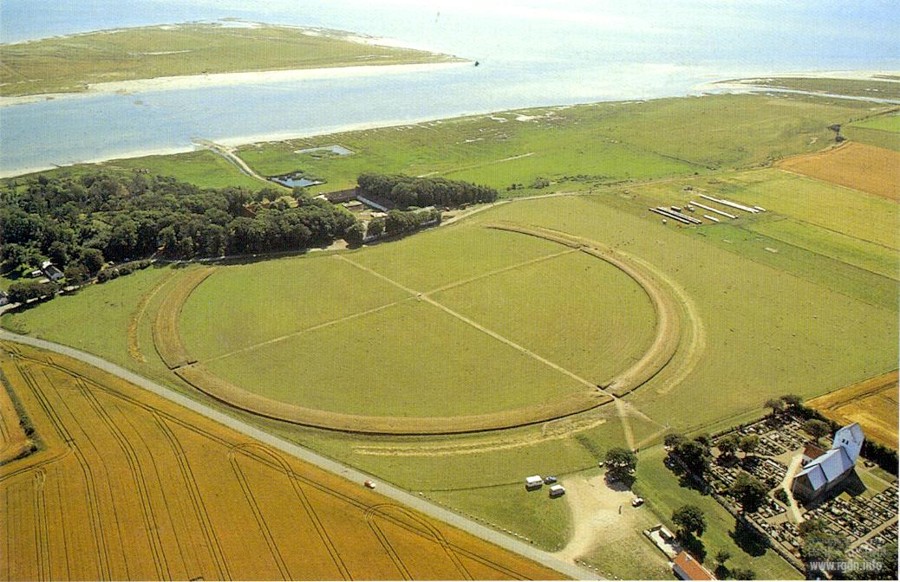
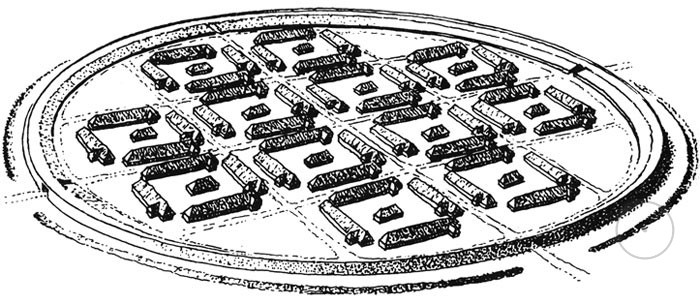
Aggersborg (image 2: Aggersborg, Denmark, second half of the 10th century)
The four Viking fortresses of Trelleborg, Eskeholm, Fyrkat, and Aggersborg are aligned. Distance: 218.5 kilometres. The line points to Delphi, Greece.
“Preben Hansson further flew by the same route. After a hundred kilometres he reached the Fyrkat archaeological site, and a little later the mighty walls of Aggersborg appeared below. All in all, the Danish pilot covered 218.5 kilometres along a straight line, having subsequently passed four Viking ring castles.
On his return home, Preben Hansson extended the line of his flight on a globe. It passed through Berlin, the Alps, Yugoslavia, and ended in Delphi, Greece.”
“Some ancient Greek cult sites are located in strict geometric conformity with each other, and very many lines pass through Delphi. Here are several examples. A line connects Delphi with Olympia, Olympia with the Acropolis of Athens, and goes back to Delphi, thus forming an equilateral triangle. Another line goes from Delphi to Nemea, and there are already two triangles. If we divide the segment Delphi – Acropolis or Delphi – Olympia according to the golden ratio, a longer segment of the golden section will equal to the distance between Delphi and Nemea.
Now, let’s draw a line from Delphi, perpendicular to the Olympia – Delphi line. It ends in Dodoni. If we connect Olympia with Dodoni, we’ll get another triangle. Nothing special? In such case let’s divide the segment Dodoni – Delphi according to the golden ratio. A longer part of the segment precisely corresponds to the distance between Olympia and Delphi. Further.
The distance between Sparta and Delphi corresponds to the longer segment of the golden section of the Sparta – Athens segment.
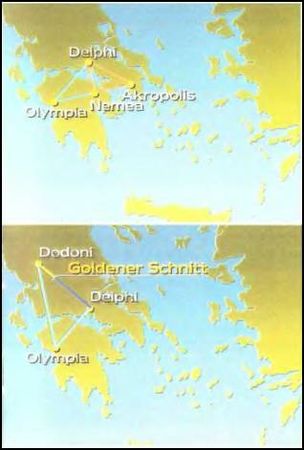
There are several more examples below:
- The distance from Delphi to Epidaurus corresponds to the longer part of the golden section of the Epidaurus – Delos segment, viz. 62 %.
- The distance from Olympia to Chalcis corresponds to the longer part of the golden section of the Olympia – Delos segment, viz. 62 %.
- The distance from Delphi to Pheben corresponds to the longer part of the golden section of the Delphi – Athens segment, viz. 62 %.
- The distance from Epidaurus to Sparta corresponds to the longer part of the golden section of the Epidaurus – Olympia segment, viz. 62 %.
- The distance from Delos to Eleusis corresponds to the longer part of the golden section of the Delos – Delphi segment, viz. 62 %.
- The distance from Knossos to Delos corresponds to the longer part of the golden section of the Knossos – Chalcis segment, viz. 62 %.
- The distance from Delphi to Dodoni corresponds to the longer part of the golden section of the Delphi – Athens segment, viz. 62 %.
- The distance from Delphi to Olympia corresponds to the longer part of the golden section of the Olympia - Chalcis segment, viz. 62 %.
And a similar picture is observed throughout the territory of Greece. The distance from Olympia to Chalcis corresponds to the longer part of the golden section of the Olympia – Delos segment.
Two of each three sites inevitably form a curve, while the third one locates in the middle of such curve.
Knossos is located in Crete. If we put a compass leg to the point which marks Knossos and draw a circle, the latter will pass through Sparta and Taros. If we take Taros as a midpoint, the circle will pass via Knossos in the south and Chalcis in the north. If Delos is taken as a midpoint, the circle will run through Pheben and Izmir, the latter located on the other side of the Aegean Sea in Turkey and used to be called Smyrna. In prehistoric times a cult site was situated there. Same applies to the rest of sites.
And there are numerous examples like this. Ancient Greece was arranged in accordance with geometric principles.
And here’s what von Däniken thinks as to mapping of the Star sign:
Phenomena such as geometric arrangements in Greece and the pentagram over Karlsruhe are found in other parts of the world as well. The Almighty Ones created them with certain intent. They could thus pursue two goals.
A spaceship crew suffering a shipwreck tried to attract attention of their fellows who were on the Earth’s orbit, by means of an enormous five-pointed star laid on the Earth’s surface. By the way, Gnostics called pentagram the “flaming star”.
At that, let me note, he further states a more reasonable idea for the second goal:
However, geometric disposition of cult sites, as well as pentagrams and straight lines which stretch for thousands of kilometres, could serve as a message to future human generations.
The message could signify the following: when people finally manage to measure their globe, sooner or later they will notice these geometric patterns. And they will start asking themselves the questions I’m now asking: how was all this possible? Who laid these lines in the remote past to ensure that right conclusions are made in the remote future?
Are we ready at least to take into consideration such conclusions which are right there on the surface?
Since we have measured the globe a rather long while ago, inquisitive people have already discovered and continue discovering numerous interesting patterns in disposition of cult sites on our planet, despite the fact official science does not acknowledge any such patterns or regularities. However, I don’t take “ostriches” into account; they may further expound their entombed theories out of the sand, and they shouldn’t be prevented from that, for this is what an ostrich life’s all about.
Whereas for intelligent people, who are not indifferent to what is around us, this is exactly the time, I think, to draw the right conclusions...
Read previous articles of the series:
Prepared by Igor
 Places of Power. Ley Lines. Part 3 of the Star. The Golden Ratio Series
votes:
420
Places of Power. Ley Lines. Part 3 of the Star. The Golden Ratio Series
votes:
420
|

Project Aim










Leave comment